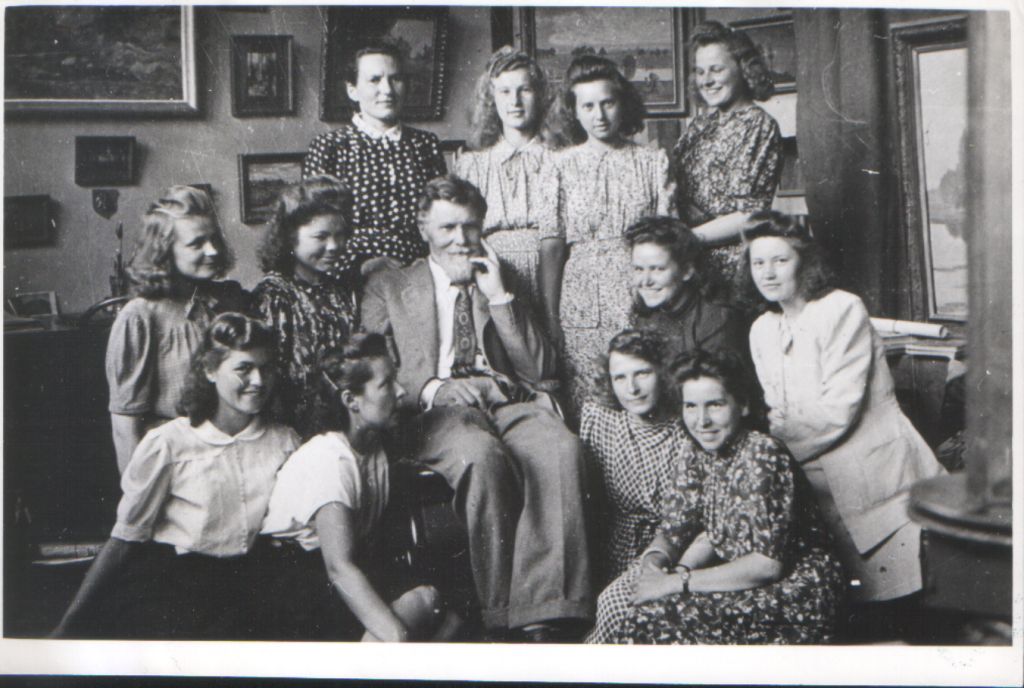The first post-war decade (1945–1955) was a period of organizational and artistic consolidation for the applied arts, which had a somewhat less rich inheritance from independent Lithuania than other artistic fields. Firstly, applied arts lacked a stabile material foundation—the technical means, materials and facilities to carry out their ideas. In the turmoil that followed the war, under an increasingly entrenched Soviet occupation, applied arts organizers attempted to establish conditions for a more systematic development of this field of art to allow them to resume the training of specialists at the Kaunas Applied Arts Institute, restart operations at the "Dailė" artistic cooperatives, and to gather together the creators of applied arts.
With the retreat of the war front westward in 1944, the Kaunas Applied Arts Institute established on the eve of military hostilities in Lithuania in 1940—was revived and renamed the Kaunas State Institute for Applied and Decorative Arts in 1945. The Institute trained ceramists as well as textile and monumental decorative artists, in addition to other specialists. The training of mid-level specialists was delegated to schools of higher art education that had evolved from their origins as fine art schools, including the Stepas Žukas Applied Arts Technical School in Kaunas (established in 1954) and the Applied Arts Technical School of Telšiai (founded in 1959).
A network of facilities centered around the "Dailė" DailėThe "Dailė" workshops were a specific phenomenon of Soviet applied artistry, of interest not only to those studying design (for the way their work was organized and how works were reproduced), but also to applied art critics (for the style of the works produced).
The Soviet "Dailė" workshops were created in the spirit of early European modernist associations that propagated the idea of a union of arts and crafts that aspired to bring art and mass production closer together. Soviet ideologists were inspired by the efforts of William Morris, a late 19th century socialist who sought to consolidate the production of all articles necessary for the home environment (textiles, ceramics, furniture, wall furnishings) in one Morris and Co. studio (opened in 1888) in England.
Similar workshops, opening one after the other in the early 20th century, continued Morris' efforts: the Wiener Werkstätten (opened in 1903) in Vienna, the Deutsche Werkbund (est. 1907), workshops in Krakow (Warsztaty Krakowskie, opened in 1913), and others. production factory was launched in 1945, and the LSSR (Lithuanian Soviet Socialist Republic) Art Fund was established to finance larger works of applied art.
The Soviet "Dailė" workshops were created in the spirit of early European modernist associations that propagated the idea of a union of arts and crafts that aspired to bring art and mass production closer together. Soviet ideologists were inspired by the efforts of William Morris, a late 19th century socialist who sought to consolidate the production of all articles necessary for the home environment (textiles, ceramics, furniture, wall furnishings) in one Morris and Co. studio (opened in 1888) in England.
Similar workshops, opening one after the other in the early 20th century, continued Morris' efforts: the Wiener Werkstätten (opened in 1903) in Vienna, the Deutsche Werkbund (est. 1907), workshops in Krakow (Warsztaty Krakowskie, opened in 1913), and others. production factory was launched in 1945, and the LSSR (Lithuanian Soviet Socialist Republic) Art Fund was established to finance larger works of applied art.
Workshops for individual fields of applied art were established at the "Dailė" facilities where artistic works were produced according to the designs, called etalonai (standards), of professional artists. In cooperation with the Art Fund, the "Dailė" facilities remained in operation until the collapse of the Soviet Union, comprising a system for the design of large orders and integrated interior spaces.
The artistic capabilities of applied artists were not alike. Many artists, fearing the Bolshevik terror, fled to the West. Ceramists had been participating in Lithuanian artistic life for many years already, and could thus benefit from the tasteful works of Liudvikas Strolis (1905–1996), who had studied in Paris before the war, as well as the work of his students: Vaclovas Miknevičius (1910–1989), Valdemaras Manomaitis (1912–2000), Jonas Mikėnas (1899–1988), and Teodora Slyvauskaitė-Miknevičienė (1909–1982). The work of the ceramists was not interrupted by the Second World War: an exhibition of Lithuanian ceramic works opened in Kaunas in 1943 and the Kaunas Applied Arts Institute continued to train ceramic artists during wartime.
Other branches of the applied arts (textiles, wood, metals, glass, jewelry) were much worse off. An odd situation developed in particular with textiles. When the husband and wife team of textile artists, Antanas Tamošaitis (1906–2005) and Anastazija Tamošaitienė (1910–1991), withdrew to the West, no professional artists remained working in this field. The art institutions in operation in Kaunas had to train the applied art specialists that Lithuania required, under the guidance of renowned artists. It was most important to achieve a creative professional level beyond that of the artisan. These different artistic fields had already become linked during the inter-war period, with artisan creations supplementing and compensating for the lack of artistic works in independent Lithuania.
The textiles department was headed from 1945 by set designer Liudas Truikys (1904–1987), while the ceramics department was directed by Liudvikas Strolis. The Institute also housed a department for monumental and decorative painting, with two studios. In one of these, Stasys Ušinskas (1905–1974) instructed in wall painting and stained glass.




Comments
Write a comment